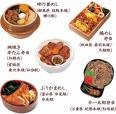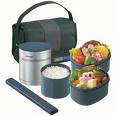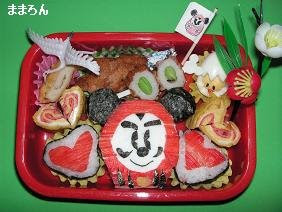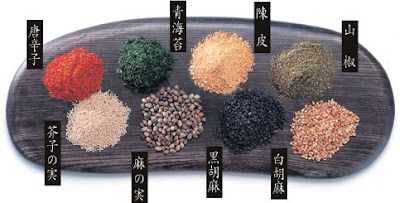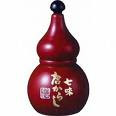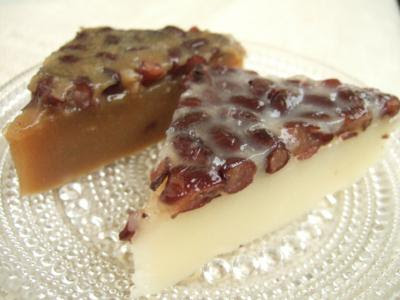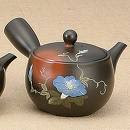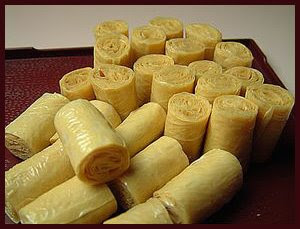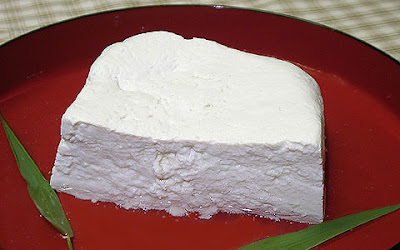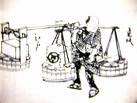. Persimmon legends and art motives .
::::::::::::::::::::::::::::::::::::::::::::::::::::::::::::::::::::::::::::::::::::::::::::::::::::
Persimmon (kaki)
***** Location: Japan
***** Season: Various, see WKD
***** Category: Plant
*****************************
Explanation
Kaki, 柿 Persimmon
WKD : Kaki Persimmon (kaki, hoshigaki) as Kigo
WKD... various kigo
Diospyros kaki
Sharon Fruit
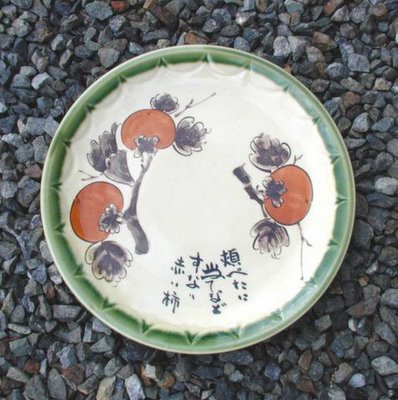
Kaki-Plate by Gabi Greve
kakinoki, kaki no ki カキノキ(柿の木)persimmon tree
There are said to be more than 1000 different kinds of KAKI in Japan.
渋柿と甘柿 shibugaki and amagaki, bitter and sweet kaki.
Die Sharonfrucht, die nach der Sharon-Ebene in Israel benannt ist, wird oft durch Chemikalien zur Reifung gebracht.
The most important sweet one is Fuyuugaki (fuyugaki) 富有柿 and Jiroo 次郎.
Bitter ones are Hachiyagaki 蜂屋 , and Hiratanenashi 平核無 (ヒラタネナシガキ)and Hatchingaki 八珍柿(はっちんがき)
anpogaki あんぽ柿(あんぽがき)type of bitter persimmon
from Tottori and and Isazawa, Fukushima
福島県伊達市梁川町五十沢(いさざわ)
They become black and hard when dried.
They can be kept 3 months in the refrigerator.
They are mixed in salads or cut finely and mixed with pickles or in yoghurt.
In Wakayama, they grow a type without kernels.
tanenashi anpogaki たねなしあんぽ柿, hiratanenashi ひらたねなし
Ichitagaki 市田柿(いちたがき)
The most famous dried persimmon
from Ichita, South Shinshuu, Nagano.
長野県下伊那郡高森町の市田地域
They are eaten for the New Year and other celebrations.
"The more kernels there are in a persimmon eaten on the first of January, the richer you will become during this year".
元旦に食べた干し柿から出てきた種の数が多いほど、
その一年で多くの富を蓄えることができる
One last kaki (or a few) is left on the tree to "watch over it"
(kimori gaki 木守柿) kimamorigaki きまもりがき
kigo for autumn
also called "taking care of the children"
komorigaki こもりがき」
komamorigaki こまもりがき
These fruit are eaten by the birds and badgers and other animals.
momo kuri sannen, kaki hachinen 桃栗3年柿8年..
it takes three years to harvest from a peach or chestnut tree
but it takes eight years to harvest from a persimmon tree.
柿が赤くなると医者が青くなる
When the persimmons get red,
the doctor becomes pale (runs out of business).
Because of its vitamins and minerals it is very healthy.
:::::::::::::::::::::::::::::::::::::::::::::::::::::::::::::::::::::::::::::::::::::::::::::::::::::
kushigaki 串柿 ( くしがき) dried persimmons on a stick
prepared in the town of Shigo, Katsuragi, in Wakayama.
They are used as a decoration for the New Year, placed on the mochi, usually in the Kansai area.
In November, there is a Shigo Persimmon Festival
 They are grown in the mountains and harvested each day for two month to prepare the dried fruit on skewers, 10 each, for good luck. This is a play with words:
They are grown in the mountains and harvested each day for two month to prepare the dried fruit on skewers, 10 each, for good luck. This is a play with words:Soto nikoniko, uchi mutsumajii ...
Outside smiling (two and two),
inside a harmonious couple (six on the inside).
So they are put on the stick in the order of two ... six ... two.
The farmer's wife puts them on skewers from morning to evening, for two months. The son binds them in layers to hang out for drying. They are dried under roofs outside and have to be taken care of when the mountain fog comes up. All are quite exhausted each year when the persimmon harvest is over ... and not even a fruit to eat.
auf Spießen getrocknete Persimonen
:::::::::::::::::::::::::::::::::::::::::::::::::::::::::::::::::::::::::::::::::::::::::::::::::::::

korogaki 枯露柿 / 古老柿 (ころがき)
bitter persimmons made sweet
. . . CLICK here for Photos !
It is the job of the farmer to get the persimmons down from the tree. The fomenfolk then do the other preparations.
The skin is peeled, they are then dried in the sunshine for a week or longer in special store shelters outside, until they are very dry and show a white powder outside, which is the natural sugar to make them taste sweet.
They were a special winter treet for many villagers in the mountains and used also for the new year decorations, like the kushigaki above.
Housewifes in the area near Uji in Kyoto also use these korogaki, add some yuzu peel and roll them to small sweets

kakiguruma 柿車 "persimmon rolls"
::::::::::::::::::::::::::::::::::::::::::::::::::::::::::::::::::::::::::::::::::::::::::::::::::::
Monbei-Gaki 紋平柿(もんべいがき)
aus Takamatsu. a bitter variety, about 300 g heavy.
. WASHOKU
Yamato no tsurushigaki 大和のつるし柿
dried persimmons from Nara prefecture
and other persimmon dishes from the Yamato area
:::::::::::::::::::::::::::::::::::::::::::::::::::::::::::::::::::::::::::::::::::::::::::::::::::
Persimmons in local lore
 Once Saint Shinran 親鸞聖人 (1173-1262) on his way to exile in Echigo (now Niigata) stayed over night in a farmhouse. He told the eager farmer Tsujihara Saemon 辻源左ェ門 all about his religion, the New Pure Land Buddhism.
Once Saint Shinran 親鸞聖人 (1173-1262) on his way to exile in Echigo (now Niigata) stayed over night in a farmhouse. He told the eager farmer Tsujihara Saemon 辻源左ェ門 all about his religion, the New Pure Land Buddhism.Outside an old grandmother 経田屋太兵衛の老婆 heared his sermon. The next morning, when Shinran passed Keitaya 経田屋, she gave him some persimmons on a stick to eat. Shinran was very pleased about this. He took three seeds out of the persimmons, which had been grilled in the hearth and were half-black, and planted them in the garden,saying: "May they bring forth buds and be witness to my beliefs!" 我が末法世に栄えるならば再び芽を生ぜよ (this is a legend, of course). And for sure, over night three young sprouts came out of the earth and grew into three persimmon trees "sanbongaki" 三本柿. The fruit and kernels of these persimmons have black spots (from the hearth fire) to this day.
Thus the whole village took the name of "persimmon village" kakigichoo 柿木町. People who tried to cut them down were severely punished. One still exists today, with replants over the years. In 1956, the town build a fence around it.
There is now one tree at the tempel Tsujitokuhoo-Ji 辻徳法寺 and its fruit have black spots as if they had been burned down. The abbot knows this: "The three trees in front of Keitaya 経田屋 became old and dry over the years, but one of them was planted to the temple and survived there, and the two others are now lost."
Niigata (Toyama) prefecture, Kurobe Town,Shimoniikawa 新川(にいかわ)/ 黒部市三島
And a sweet with white beans and dried persimmons sold in Kurobe Town in honor of this legend.

黒部市三日市 Kurobe Town , Mikkaichi Town
There is even a haiku about these trees.
佛恩の柿の茂りと見上げたり
butsuon no kaki no shigeri to miagetari
I look up to it -
this leafy persimmon tree
with a Buddha legend
Igarashi Bansui (1899-1920) 五十嵐播水
Shinran had been in exile for five years in Echigo (now Niigata), but was pardoned in1211.
Saint Shinran / More in the WIKIPEDIA !
Shinran lebte 5 Jahre im Exil in Echigo. Neue Joodo Sekte des Reinen Landes. 浄土真宗
. . . . .
Der Heilige Shinran und die drei Persimonenbäume
Shinran (1173-1263) war ein buddhistischer Mönch, bekannt als Begründer der „Neue Sekte vom Reinen Land“. Er studierte zunächst mehr als 20 Jahre lang in Kyoto im Bergkloster auf dem Hiei-Zan, distanzierte sich dann aber von der Lehre des esoterischen Buddhismus und folgte Honen (1133-1212), der die „Sekte vom Reinen Land“ begründet hatte und eine einfache, fromme Anrufung des Buddha Amida propagierte. Nach Streitereien mit den orthodoxen Lehren des Buddhismus wurde Honen und bald auch Shinran in die Verbannung geschickt. Auf seinem Weg in die Verbannung nach Echigo (heute die Präfektur Niigata) ereignete sich die folgende Episode.
Shinran übernachtete im Haus des Bauern Tsujihara Sa-emon in einem Dorf in der Nähe der heutigen Stadt Kurobe. Die beiden Herren verstanden sich auf Anhieb und Shinran verbrachte die ganze Nacht damit, dem Bauern seine Lehre zu predigen. Eine alte Nachbarin hörte ebenfalls interessiert zu. Als Shinran am nächsten morgen weiterziehen wollte, kam die Alte und brachte ihm ein paar Persimonen als Wegzehrung. Er verpeiste sie sofort, nahm die drei Kerne, die von der Herdasche schon fast schwarz waren, und pflanzte sie im Vorgarten der alten Frau mit dem Spruch: „Mögen sie sprießen und Frucht bringen, so wie meine neue Lehre!“ Und siehe da, bereits am nächsten Morgen begannen sie zu sprießen und drei stattliche Persimonenbäume wuchsen heran. Die Früchte und die Kerne haben bis heute schwarze Stellen.
Diese drei Bäume wurden liebevoll gepflegt und immer wieder durch Aufpfropfen erhalten, aber zwei davon gingen im Laufe der Zeit doch ein, während der dritte nach dem Umpflanzen in das Gelände des Tempels Tsujitokuhoo-Ji bis heute überlebt hat und hinter einem stattlichen Steinzaun hoch aufragt. (foto erwünscht)
In der Stadt Kurobe wird heute in Erinnerung an den Aufenthalt des Heiligen Shinran eine Waffel mit süßem weißem Bohnenmus und kleinen Persimonenstücken verkauft, die den stolzen Namen trägt „Die drei Persimonenbäume“ (sanbongaki).
Als der Haiku-Meister Igarashi Bansui (1899-1920) einmal hier vorbeikam, schrieb er folgendes Kurzgedicht:
butsu-on no kaki no shigeri to miagetari
hoch sehe ich auf –
dieser grünende Persimonenbaum
mit einer Buddhalegende
Die „Sekte des reinen Landes“ nach den Lehren von Honen und Shinran, mit dem Westlichen und Östlichen Tempel Hongan-Ji in Kyoto als Mittelpunkt, ist inzwischen weltweit verbreitet. Auch in Deutschland gibt es Gruppen, die dieser Lehre folgen.
. Honganji 本願寺 Hongan-Ji, Hongwanji . Kyoto
:::::::::::::::::::::::::::::::::::::::::::::::::::::::::::::::::::::::::::::::::::::::::::::::::::::

Rakushisha 落柿舎(らくししゃ)
"Hermitage of the fallen persimmon"
is the cottage of Genroku poet Mukai Kyorai 向井去来.
Kyorai was one of ten disciples of the haiku poet, Matsuo Basho.
The cottage was listed in the Shui Miyako Meisho Zue, an Edo period travel book that listed famous places to see in Kyoto. The name of the place is derived from a story of how Kyorai achieved enlightenment.
As the story goes, Kyorai had forty persimmon (kaki) trees planted around the hut. One autumn, when they were heavy with fruit, he had arranged to sell the persimmons. But during the night before they were to be picked, a great storm arose. The following morning, not a single persimmon remained on the trees. As a result Kyorai was enlightened and from that point forward called the hut and garden, Rakushisha or 'the cottage of the fallen persimmons'. The poem he wrote for the occasion is inscribed on a stone in the garden:
かきぬしや こずえはちかき あらしやま
柿主や梢はちかきあらし山
kakinushi ya kozue wa chikaki Arashiyama
Master of Persimmons
Treetops are close to
Arashiyama
There's a bit of word play here. Arashiyama is a mountain near Kyoto but it means literally 'Storm Mountain'.
Basho visited here three times, in 1689, 1691 and 1694.
source : jgarden.org : Rakushisa
Main Entry
. Mukai Kyorai 向井去来 (むかい きょらい) .
1651 - 1704
. Mukai Chine 向井千子 . (? - 1688)
his sister, who died very young, age 25 only.

source : Naokimi Yamada - facebook
yagate chiru . . .
Basho in Saga
Eight Basho haiku, one renku, seven passages of prose and two of his letters,
Translations and Commentary by Jeff Robbins - Assisted by Sakata Shoko
- source : writersinkyoto.com - (Robbins) -
:::::::::::::::::::::::::::::::::::::::::::::::::::::::::::::::::::::::::::::::::::::::::::::::::::::::
Arashiyama 嵐山 "Storm Mountain"
is a district on the western outskirts of Kyoto, Japan. It also refers to the mountain across the Ōi River, which forms a backdrop to the district. Arashiyama is a nationally-designated Historic Site and Place of Scenic Beauty.

Iwatayama Monkey Park
"Moon Crossing Bridge" (渡月橋,Togetsukyō), Togetsukyo
tombstone of the Heike courtesan Kogo of Sagano
hamlet of Kiyotaki and Mt Atago
Kameyama koen
© More in the WIKIPEDIA !
六月や峯に雲置あらし山
rokugatsu ya mine ni kumo oku Arashiyama
Matsuo Basho 松尾芭蕉
the six month -
clouds are laying on the summit
of Mount Arashiyama
Tr. Gabi Greve
the sixth month --
with clouds laid on its summit
Mount-Arashi
Tr. Ueda Makoto
Basho is referring to the sixth lunar month.
. Matsuo Basho 松尾芭蕉 - Archives of the WKD .
:::::::::::::::::::::::::::::::::::::::::::::::::::::::::::::::::::::::::::::::::::::::::::::::::::
Dishes with persimmons 柿料理 kaki ryoori

The most representative food of autumn in Japan.
Rich in vitamin C and carotin.
They can be cut finely and mixed with meat and curry dishes.
The stem is dried and made in to a kind of Chinese medicine, shitii 柿蒂(シテイ), good for cough.
The leaves contain Vitamin C, B and K and other minerals. They are also made to a kind of tea-medicine. Their antibacterial properties make them good for wrapping sushi rice.
kaki no ha sushi (柿の葉寿司)
(kakinoha sushi) Sushi-Reis umwickelt mit Persimonen-Blättern
The fresh leaves of spring are made into tempura.
kaki no sunomono 柿の酢の物 prepared with sweet vinegar
. . . CLICK here for Photos !
kaki no aemono 柿の和え物 with tofu dressing
. . . CLICK here for Photos !
kaki no ha sushi (柿の葉寿司)Sushi wrapped in Persimmon leaves
speciality from Nara, Wakayama, Ishikawa prefectures.
In Nara, the leaves are pickled with salt and let ferment. It is sold at the airport and train stations.
Meat from Salmon, tai and anago is put on the sushi rice.
. . . CLICK here for Photos !
often used in the temple kitchen
for shoojin ryoori 精進料理.
jamu 柿ジャムpersimmon jam
Wagashi . Japanese Sweets
Persimmon and Sweets
*****************************
Worldwide use
Persimone, Diospyros kaki. Kakipflaume; Sharonfrucht.
*****************************
Things found on the way
*****************************
HAIKU

串柿が障子に残す影三つ
kushigaki ga shooji ni nokosu kage mitsu
three shadows
from persimmons on a stick
on the paper door
Hayu はゆ
kushigaki, kigo for autumn
:::::::::::::::::::::::::::::::::::::::::::::::::::::::::::::::::::::::::::::::::::::::::::::::::::::
柿くへば鐘が鳴るなり法隆寺
kaki kueba / the famous persimmon haiku
Masaoka Shiki
kaki kueba kane ga naru nari Horyuji
*****************************
Related words
***** aogaki 青柿 (あおがき) green persimmon
kigo for late summer
***** WASHOKU : INGREDIENTS
. PLANTS - - - the Complete SAIJIKI .
:::::::::::::::::::::::::::::::::::::::::::::::::::::::::::::::::::::::::::::::::::::::::::::::::::::::::::::::::::::::::::
[ . BACK to DARUMA MUSEUM TOP . ]
[ . BACK to WORLDKIGO . TOP . ]
- #kaki #persimmon -
:::::::::::::::::::::::::::::::::::::::::::::::::::::::::::::::::::::::::::::::::::::::::::::::::::::::::::::::::::::::::::
